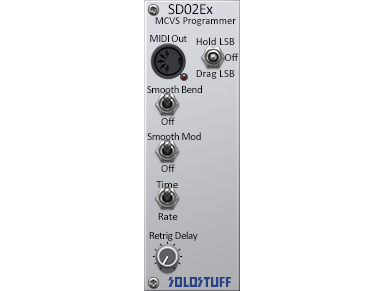Product Description
(This module is included in the System B)
The SD02Ex is an expander module for the SD02 MIDI-CV/Sync module. It exposes some of the hidden functionalities available in the SD02.
The way it works is to connect the MIDI out of the SD02Ex to the MIDI In of the SD02. The moment this is done, the SD02Ex will send specialized MIDI messages to the SD02 to program and synchronize it’s internal settings to whats currently set on the SD02Ex front panel. From there you can tweak and change the settings further on the SD02Ex, any changes made will be immediately sent to the SD02. Once your done, you can disconnect the SD02Ex from the SD02. And proceed with normal operation on the SD02. The SD02 will keep remembering it’s new settings. These settings will also be automatically saved when presets and DAW projects are saved. No need to reprogram with the SD02Ex again unless you want to change the settings.
MIDI CC messages (in this case modulation wheel and channel volume) are sent by hardware controllers in either 7 bit resolution or 14 bit resolution. 7 bits provide a rather low stepy resolution of 128 values for a complete knob/fader tweak. While 14 bits provide a much higher resolution of 16384 values for a complete knob/fader. Unfortunately, only a few hardware controllers seam to support 14 bit mode.
Notice that pitch bend is always 14 bit imposed by the MIDI standard. And Aftertouch is always 7 bit imposed by the MIDI standard.
The SD02 and SD02Ex support both 7 bit and 14 bit resolutions. They also provide automatic smoothing to overcome the stepiness of the 7bit mode. You can turn off that smoothing using the Smooth mod switch. In 14 bit, the smoothing should not be needed, so it better be turned off as it just adds an unnecessary minor lag. Aftertouch will be always smoothed regardless, because it’s restricted to 7bits by MIDI.
The Smooth Bend can turn on or off smoothing for pitch bend. Smoothing here is not necessary since pitch bend is always 14 bit as mentioned above. But we put the feature here just in case.
The Time/Rate switch determines the mode in which the Glide in the SD02 works. The default is Time mode, which means that any glide between notes will take a fixed amount of time regardless of how far or close the notes are to each other. The Glide knob will set that fixed time. In Rate mode, the speed/rate at which the glide happens is the fixed thing that is set by the Glide knob. In this mode, far away notes will take longer to glide than close notes.
The Retrig delay works when the SD02 is set to Multi mode. When a new note is received while another note is being held, Multi mode causes the Gate out to re-trigger again meaning that it will go low and then high immediately. This Retrig delay sets how long the Gate out waits after it goes low and before it goes high again. This waiting is essential if you like to send that trigger to external hardware which may not be able to detect the very brief low voltage state. The minimum delay time is 1 sample* and the maximum is 127 milliseconds.
Technical Details
The following details are too technical and concern the Hold LSB/Drag LSB/Off. If you don’t want to bother, just put it to Off. It should work well most of the time.
14bit CC messages are sent using two messages, an MSB (course) and an LSB (fine)*. If there is a delay between the two messages, the receiver does not have the full value during that delay. Hence, the receiver should decide what to do with this half information while the remaining half is received. What complicates this further is that there doesn’t seams to be a defined standard as to which of the two messages is sent first!!. Some hardware controllers send MSB first, others send LSB first. The Hold LSB/Drag LSB/Off switch defines what to do in this case. When put on Off the SD02 will simply apply what ever messages it gets sent immediately on the current CC value and output that to CV (mod wheel and volume). If you think of it for five minutes, you will figure out it should work but will cause very brief incorrect value jumps. The Drag LSB mode is designed to work better when the sender sends MSBs before LSBs, it temporarily changes the the current LSB value in a way that smooths transitions until the real LSB is received. The Hold LSB mode is designed to work better when the sender sends LSBs before MSBs. It saves the LSB value but never applies it to the output CV until the MSB is received. Note here that this mode will NOT work if the sender only sends LSBs, (like for example in compact mode in the SD12). The sender has to send the pair for this mode to work.
*One sample time is 1/(sampling rate) or 1/(oversampling rate). So for 44.1Khz, the time is 0.022 milliseconds.


Reviews
There are no reviews yet.